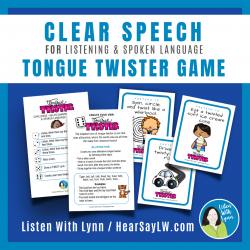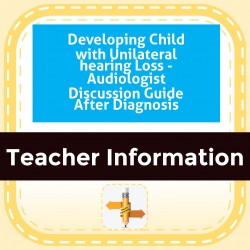Ability Levels
Categories
Resource Types
Age/Grade Range
CCSS
Anchor Standard
Speaking & Listening
Language
Reading
Article: Predicting Speech Audibility from the Audiogram to Advocate for Listneing and Learning Needs.
$ 0
The SpeECH- Audibility Audiogram for Classroom Listening is based on the Count-the-Dot Audiogram and provides an estimate of percent audibility in quiet and noise for different ranges of hearing loss.
...
This article describes use of this tool.
What is Reverberation and Why does it Make it so Hard to Listen?
$ 3
Discussion handout describing the challenge of understanding speECH- in reverberant listening environments.
Common Children's Phrases - Spanish Translation
$ 0
Stimuli that can be used when performing the Functional Listening Evaluation with young children. Spanish translation.
Ling Madell Hewitt(LMH) Sound Check Documenation
$ 0
The LMH Sound Check Documentation form helps capture 3 weeks of data on a student’s hearing device and FM/HAT system use. This tool provides clear evidence of device function and student listening ac
...
access, making it ideal for IEP/ARD meetings, service justification, and collaboration with audiologists.
Speech Spectrum Audiogram for Consonant Sounds
$ 0
SpeECH- sounds occur across frequency ranges and are usually not restricted to one audiometric frequency. An audiogram shows the spread of frequency range for consonants. This page also includes a lis
...
t of consonants, their presence at each frequency and relative loudness.
Common Children's Phrases - fillable
$ 0
Stimuli that can be used when performing the Functional Listening Evaluation with young children. Partially fillable.
Article: RelationsHIPS Among Speech Perception, Production, Language, Hearing Loss, and Age in Children with Impaired Hearing
$ 0
This article describes the results of a study of 87 children with hearing loss that were evaluated over a 3-year period. Results suggest that children will reach a level of over 90% sentence recogniti
...
on in the auditory/visual condition when their language becomes equivalent to that of a normally-hearing 7-year-old. They will enter school at age 12 with an average language delay of 4-5 years unless they receive concentrated and effective language training. 2001
TONGUE TWISTER CHALLENGE GAME FOR CLEAR SPEECH
$ 6
Do you have kids who need practice using clear and natural-sounding speech? The Tongue Twister Challenge Game is hilarious and gets kids listening, moving, and engaged! The game sharpens listening and
...
d spoken language skills. It is a game kids ask to play again and again and a must for your toolbox!
The Tongue Twister Challenge Game ➼ Targets CLEAR SPEECH Helps children learn to use natural prosody (rate of speech, volume, intonation, pausing, and fluency. Provides practice to learn to say each syllable and speech sound carefully and precisely.
➼ Develop AUDITORY skills.
Uses the auditory feedback loop. Increases auditory memory and recall. Builds strong phonological awareness skills.
➼ Broadens LANGUAGE skills. Teach the vocabulary used in the tongue twisters.
Reinforces grammar, synonyms, antonyms, and more.
➼ Encourages SOCIAL skills.
Kids practice saying tongue twisters to each other while gaining confidence and interacting in the game.
The Tongue Twister Challenge Game is great for ✧ Tongue Twister Tuesdays ✧ 1:1 Sessions
✧ Small Groups
✧ Class Game
✧ Home Practice
✧ Skill Practice or Review
Includes: • Challenge game cards
• 12 Twist game cards
• 50 tongue twisters • Listen & Spoken Language Tips
◈ ◈ ◈ ◈ ◈ ◈ ◈ ◈ ◈ ◈ ◈ ◈ ◈ ◈ ◈ ◈ ◈ ◈ ◈ ◈ ◈ ◈ ◈ ◈ ◈ ◈ ◈ ◈ ◈ ◈ CUSTOMER TIPS ➼ Questions? EMAIL ME before purchasing this resource or anytime later.
♥ Sign up HERE for the Listen With Lynn Emails
♥ Let’s Connect
Instagram
Facebook Keep up your good work. I am blessed to help along the way.
Thanks so much! Lynn Wood
Developing Child with Unilateral hearing Loss - Early Interventionists
$ 19
This step‐by‐step guide has been developed to share with families after unilateral hearing loss has been diagnosed, typically in infancy secondary to identification through newborn hearing screening.
...
ng. The guide reviews background information regarding what is known about the effects of hearing loss in one ear on child development. It is divided into suggested sections to correspond with pediatric audiology appointments and with home visits by an early interventionist (teacher of the deaf/hard of hearing or speech language pathologist). Three is a focus on language and social development and a trial with amplification.
Developing Child with Unilateral hearing Loss - Audiologist Discussion Guide After Diagnosis
$ 12
This step‐by‐step guide has been developed to share with families after unilateral hearing loss has been diagnosed, typically in infancy secondary to identification through newborn hearing has been di
...
n diagnosed, typically in infancy secondary to identification through newborn hearing screening. Designed for use by pediatric or educational audiologists. The guide reviews background information regarding what is known about the effects of hearing loss in one ear on child development. It is divided into suggested sections to correspond with pediatric audiology appointments and with home visits by an early interventionist (teacher of the deaf/hard of hearing or speech language pathologist).
 Your browser is out of date. For best experience switch to latest updated Browser.
Your browser is out of date. For best experience switch to latest updated Browser.
 Get Chrome
Get Chrome Get Edge
Get Edge Get Firefox
Get Firefox









